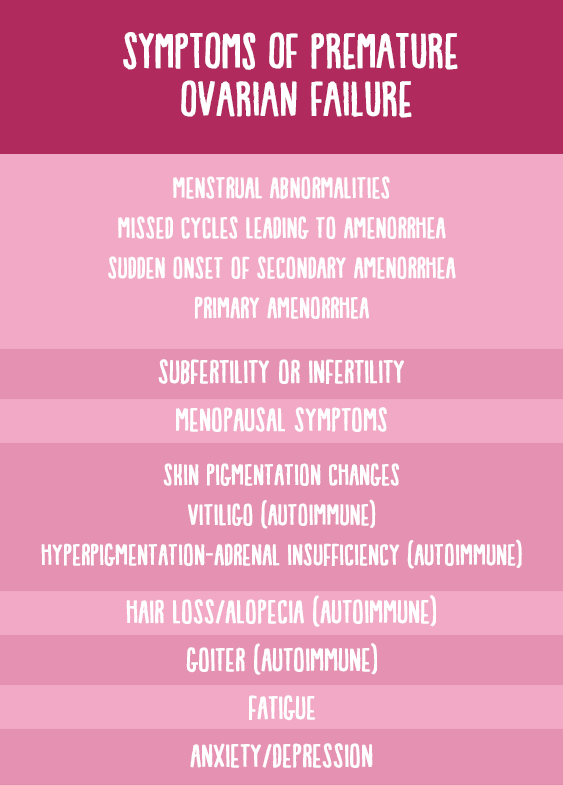Premature Ovarian Failure Symptoms
Menstrual irregularities can be the first indicator of POF
Symptoms of premature ovarian failure are highly variable.
They include both manifestations of hormone deficiencies and symptoms of potential underlying disorders causing the condition.
Diagnosis can be complicated by the fact that women with this condition retain some ovarian function that can lead to fluctuation in hormone levels and possibly sporadic spontaneous ovulation.
Among ovary-related signs and symptoms are absence of menstruation (amenorrhea), infertility, estrogen deficiency, reduced ovarian follicles and elevated gonadotropins (the hormones acting on the ovaries) before the age of 40 years.
Low estrogen levels in the serum are due to a low number of antral follicles (the small follicles detectable by transvaginal ultrasounds and whose number represents a reliable marker of the ovarian reserve) and granulosa cells (the cells closely associated with the developing oocyte) activities.
Consequent new-onset menstrual irregularities can be the first indicator of premature ovarian insufficiency.
In some cases they presents as infrequent menses, in some other as too frequent menstruations; these irregularities precede amenorrhea, which in the majority of cases is of the secondary type.

Clinical presentation of premature ovarian failure. Adapted from Torrealday S et al, 2017.
Criteria for diagnosis
Criteria for diagnosis are:
- serum FSH (follicle-stimulating hormone) levels greater than 25 IU/L on two separate occasions at least one month apart;
- concomitant E2 (estradiol) levels lower than 50 pg/mL;
- amenorrhea for at least 4 months in women younger than 40 years old.
However, some authors suggest premature ovarian failure should be already considered among possible causes of loss of regular menses for 3 consecutive months in an otherwise healthy, non-pregnant woman.
Very low (or undetectable) levels of AMH (anti-mullerian hormone) and pelvic ultrasounds can reaffirm the suspect of premature ovarian failure. Endometrium thickness lower than 4 mm, a small ovarian volume, and an antral follicle count lower than 5 are all consistent with the presence of this condition.
In some women the estrogen-deficient status causes menopausal symptoms such as hot flashes, vaginal dryness, decreased libido, painful intercourses, mood instability, night sweats or sleep disturbances. Notably, these problems can be particularly severe in case of premature ovarian failure caused by a medical procedure. In contrast, they may never develop in case of primary amenorrhea, when symptoms of low estrogen levels are rare too.
Finally, some women can be diagnosed with premature ovarian failure in the absence of symptoms other than infertility, during evaluation for fertility issues.

